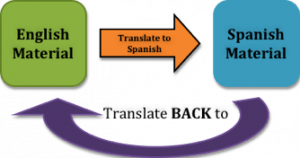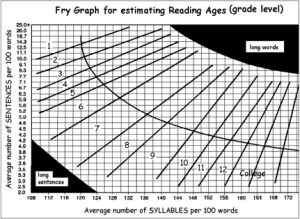In this page
- Ensuring Culturally Appropriate Translation
- Back Translation
- Literacy and Reading level
- Literacy In Translation
- Readability Tests
Cultural, Translation and Reading Level Considerations
If your target audience includes people who speak languages other than English, translation of your materials will be an important part of your project. You may have someone on staff who is fluent in a particular language that can translate your materials. If not, you’ll need to hire a reputable translation service, preferably one with experience translating public health messages. See Translation Services as a starting point to finding an appropriate professional translator for your project.
Ensuring Culturally Appropriate Translation
Since translation involves cultural and literacy limitations, involve people from the intended audience, who can provide insight in terms of overall approach and design as well as cultural appropriateness. This will ensure conveyance of meaning and adaptation to realities in those communities, and utilization of natural expressions and appropriate words that truly express the intended meaning in the language of choice.
Cultural appropriateness of images is also very important. See Step 6: Using Compelling and Appropriate Images.
Back Translation
To ensure the most accurate translation, have another person/source (someone who did not do the original translation) translate the material back into English—which is called back translation. Back translation ensures that the material was translated culturally, not just literally.
The emphasis in back translation should be on conceptual and cultural equivalence and not linguistic equivalence. Although this may involve additional time or cost, back translations are a helpful tool for ensuring truly accurate translations.
Literacy and Reading Level
“Reading level” refers to the number of years of education required to understand a written document. As many as one in five American adults reads at the fifth-grade level. For older Americans (65 and over) and inner-city minorities, almost two out of five read below the fifth-grade level. According to the 2003 National Assessment of Adult Literacy, only 12% of 19,000 adults surveyed were found to have proficient health literacy. Clearly it is important to know your audience and to understand their reading level.
Literacy in translation
When translating educational materials, don’t assume that the literacy level of the original English materials will be the same in the translated material—the literacy level may be higher or lower in the new language. To ensure consistency of reading level, conduct pilot tests in the community where you will use the materials to see whether they will be well received. See Step 8: Testing Your Materials.
Readability Tests
A number of well-established readability formulas can help you test for literacy level. Such readability formulas:
- provide a benchmark of your document’s reading level;
- can be used as a training tool or guide for writing;
- validate and support the use of plain language and design; and
- help measure whether a written piece will be too complex for the reader.
What are the limitations of readability formulas?
Keep in mind that readability tests can only be used to determine appropriate reading level. They do not affect the complexity of the concepts you’re trying to convey, impact the cultural relevance and use of appropriate images, or enhance a reader’s familiarity with the content of your materials.
We recommend the SMOG (Simplified Measure of Gobbledygook) readability test.
The SMOG Readability Formula should be used when the document has 30 or more sentences. You can also determine reading grade level using the online SMOG calculator. Follow these four steps to calculate the reading grade level:
- Pick a passage with at least 30 sentences.
- Choose 10 consecutive sentences at the beginning, 10 at the middle and 10 at the end of the piece.
- Count all of the words containing three or more syllables, including repetitions.
- Use the SMOG conversion table to determine reading level:
|
Word Count |
Grade Level |
|
0-2 |
4 |
|
3-6 |
5 |
|
7-12 |
6 |
|
13-20 |
7 |
|
21-30 |
8 |
|
31-42 |
9 |
|
43-56 |
10 |
|
57-72 |
11 |
|
73-90 |
12 |
|
91-110 |
13 |
|
111-132 |
14 |
|
133-156 |
15 |
|
157-182 |
16 |
|
183-210 |
17 |
|
211-240 |
18 |
The SMOG grade level is the reading level a person must have reached to fully understand the materials.
Other readability tests available are:
- Fry Graph
- FOG Index (also known as Gunning-Fox)
- Flesch-Kincaid Grade Level Readability Formula
1. Fry Graph is commonly used to assess the readability of a document. To use Fry Graph:
- Select three 100-word passages from your materials, one each from the beginning, middle and end.
- Count the number of sentences in each passage.
- Count the number of syllables in each passage.
- Average the number of sentences and syllables.
- Find the corresponding number set on the Fry Graph shown below.
2. The Fog Index is for documents with fewer than 30 sentences. To use the Fog Index:
- Count the total number of words in the document.
- Count the number of big words (words with three or more syllables).
- Count the number of sentences.
- Calculate the average sentence length (words in a sentence) in the document. Divide the total number of words by the total number of sentences.
- Calculate the percentage of big words in the document by dividing the number of big words in the document by the total number of words in the document and multiplying by 100.
- Add the average sentence length and percentage of big words together (steps 5 and 6).
- Multiply the sum by 0.4. The resulting number is the Fog Index or grade level.
You also can use an online Fog Index calculator.
3. The Flesch-Kincaid Grade Level Readability Formula is a built-in Microsoft Word application. It does not have the capability to score above twelfth grade; anything above that level will be reported as twelfth grade.
This is how the Flesch-Kincaid Formula works:
- Calculates the average number of words used per sentence.
- Calculates the average number of syllables per word.
- Multiplies the average number of words by 0.39 and adds it to the average number of syllables per word multiplied by 11.8.
- Subtracts 15.59 from the results.
- The resulting number indicates the grade level needed to read the document.
More information about these and other readability formulas, as well as some useful readability calculators, is available online.


